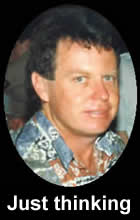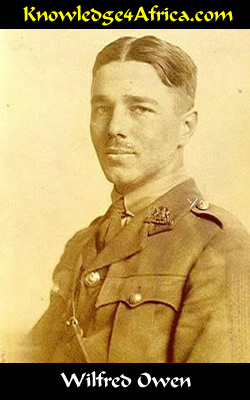|
READ THIS
Owen is a renowned anti-war poet. All his poems are set in the trenches of the Great War (1st
World War) and each aims to show through the use of shock images how grotesque and
inhuman warfare really is.
Owen himself fought in the trenches but, ironically, was killed just one week before the end of
the war in 1918.
 SOME POETIC TECHNIQUES USED
SOME POETIC TECHNIQUES USED
Line 1:
"those who die as cattle" -- a simile showing how the soldiers are no more important than
cattle which are lead to the slaughter without feeling.
Line 2:
"monstrous anger" -- the poet portrays clearly his anger at war.
Line 3:
"stuttering rifles rapid rattle":
"stuttering" = personification and onomatopoeia;
"rifles rapid rattle" = alliteration and onomatopoeia.
All of this portrays the sound and feeling of the guns firing in quick succession.
Line 4:
"patter" -- onomatopoeia illustrating the dull sound of bullets hitting the earth walls of the
trenches, comparing it to the dull muttering of prayers.
Line 7:
"shrill, demented choirs" -- the expression of the futility of warfare, that it is something
quite insane but also something that drives soldiers mad.
Line 11:
"holy glimmers of goodbyes" -- the dull gleam of light reflected in dead eyes, compared
to candles held by altar boys.
Line 14:
"each slow dusk a drawing-down of blinds" -- a double metaphor here:
dusk draws the curtains on a passing day;
death draws the curtains on life.
IMAGERY
The vehicle for this poem is the sustained or extended metaphor of a funeral where the poet
looks at the trappings of a typical funeral in a church and compares it with what would happen
to a soldier killed in battle:
church bells = the noise of gun-fire
prayers = rapid rifle fire
choirs = the wailing of shells, plus the bugle calls
candles held by altar boys = the light of the sky reflected in the unclosed dead eyes of the
soldiers
pall covering the body = pale colour in the faces of the bereaved women back home
flowers = kind thoughts of those back home
Notice too the numerous references to the madness and futility of war:
"die as cattle";
"monstrous anger";
"stuttering rifles rapid rattle";
"mockeries";
"shrill demented choirs".
Have you looked at the questions
in the right column?
|
TEST YOURSELF!
Read the left column and then answer
the following questions:
The title of this poem -- ANTHEM FOR DOOMED YOUTH -- is ironic.
- Discuss how the poet uses this irony to sum up his philosophy as presented in this
poem. (3)

[Need help?]
An anthem, according to the Oxford Dictionary, is a solemn hymn of praise. But that is certainly
not what the poet is expressing, is it? There is certainly no hint of praise.
Indeed, the poet's main point is that there is no real anthem for the doomed youth at all, only
anger and sorrow at their passing -- and outrage that they meant little more than cattle.
|
"What passing-bells for these who die as cattle?"
- How effective is this opening question as a statement of the poet's philosophy towards
warfare? (3)

[Need help?]
Cattle serve only the purpose of those who send them to their slaughter. There is no emotion
over their deaths. There is no respect for the sanctity of them as beings. The poet, in
comparing the soldiers to cattle, states graphically that they serve only as cannon fodder for the
warlords. There is no humanity, no emotion, no respect for the soldiers.
|
How does the ARGUMENT of the Octave differ from that of the Sestet? Or is this a trick
question? (4)

[Need help?]
Is this a Shakespearian or a Petrarchan sonnet? If one looks at the rhyming couplet, we should
conclude it is a Shakespearian sonnet.
There are, however, problems. A Shakespearian sonnet has three quatrains which contain the
argument, while the conclusion is contained in the rhyming couplet. This, however, does not
happen here. Indeed, the theme of the third Quatrain is continued into the rhyming couplet.
The structure itself does closely resemble that of a Petrarchan sonnet. Indeed, many texts
break the poem at the end of line 8, thereby creating an Octave and a Sestet. But a Petrarchan
sonnet has an argument in the Octave, and another argument in the Sestet. Does this happen
here? Indeed not! This sonnet contains just one argument throughout all 14 lines!
"Anthem for Doomed Youth" should therefore probably be placed in a category of its
own, namely a Modern Sonnet. But be careful: examiners might read this sonnet either as a
Shakespearian or Petrarchan version.
|
What type of sonnet is this? Justify your answer. (4)

[Need help?]
If you have read the answer to the previous question, you will now know. If not, then please go
back to the previous question.
|
What would be the BEST word to describe the tone of the poem? Justify your answer. (4)

[Need help?]
The poet is really angry, is he not? The words of anger abound throughout this poem: "for
those who die as cattle"; "monstrous anger"; "rifles' rapid rattle"; "shrill,
demented choirs". The mere concept of warfare angers the poet.
|
Is the final line a fitting conclusion to the sonnet? Justify you answer. (4)

[Need help?]
After the harshness of the sonnet as a whole, this final statement contains a welcome relief,
doesn't it? After all the harshness of battle depicted earlier, in the end there is eternal rest at
the conclusion of a brutal day.
On the other hand, the poet has been using the image of the funeral. The final line concludes
by saying that this "funeral" happens every day on the battle front.
|
What is the poet's attitude towards war? Discuss with reference to the words and images used
in this sonnet. (6)

[Need help?]
Wilfred Owen is a celebrated antiwar poet. All his poems depict warfare in its brutality,
inhumanity, savagery. He sees warfare as idiotic, demented, insane. It is ironic that he was
killed in the trenches just one week before the end of the war!
What effect do the following words have?
"for those who die as cattle";
"monstrous anger";
"rifles' rapid rattle";
"shrill, demented choirs".
|
|



